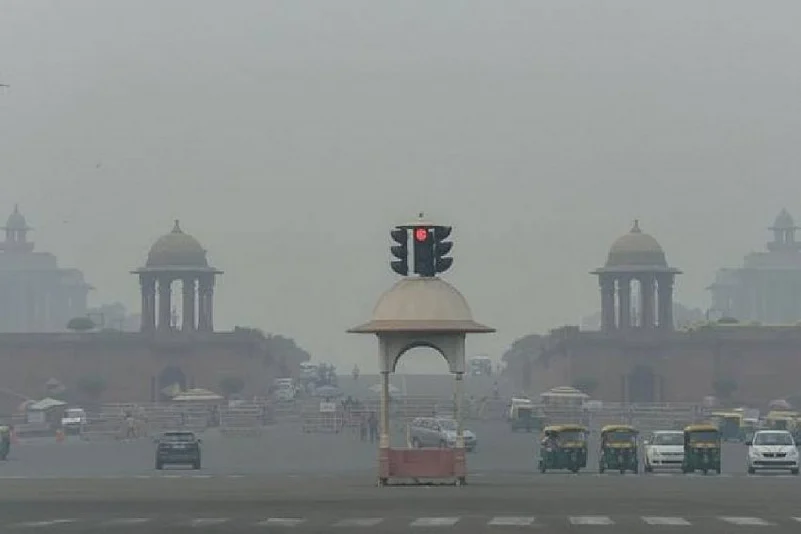Once again, Delhi’s air quality was recorded in the “poor” category on Thursday morning and it is likely to deteriorate further due to an increase in stubble burning in Punjab and Haryana and unfavourable meteorological conditions.
The city recorded an air quality index (AQI) of 201 at 9 am, which falls in the poor category.
Delhi's air quality had turned poor even on Wednesday, the first time in since June 29, with the Central Pollution Control Board recording a 24-hour average AQI of 215. It was 178 on Tuesday.
An AQI between 0 and 50 is considered 'good', 51 and 100 'satisfactory', 101 and 200 'moderate', 201 and 300 'poor', 301 and 400 'very poor', and 401 and 500 'severe'.
PM10 levels in Delhi-NCR stood at 234 micrograms per cubic meter (µg/m3) Wednesday evening, according to CPCB data. PM10 levels below 100 µg/m3 are considered safe in India.
PM10 is particulate matter with a diameter of 10 micrometers and is inhalable into the lungs. These particles include dust, pollen, and mold spores.
The levels of PM2.5 – finer particles that can even enter the bloodstream – were 93 µg/m3. PM2.5 levels up to 60 µg/m3 are considered safe.
The Ministry of Earth Sciences' air quality monitor, SAFAR, said, “PM2.5 is now becoming the lead pollutant instead of PM10 -- a characteristic of winters.”
Surface winds are calm at night. Similar conditions are likely for another two days. The AQI is expected to deteriorate further till October 10, it said.
“The boundary layer wind direction and speed are favourable for slow transport (of pollutants) from external sources and local conditions are conducive for the accumulation of pollutants in Delhi,” SAFAR said.
According to Punjab government data, 169 farm fires were observed in the state on Wednesday. Overall, 1,692 “fire events” have occurred this season so far.
In Haryana, authorities have reported 526 farm fires this season so far.
Thursday morning, Delhi's minimum temperature settled at 19.1 degrees Celsius. The wind speed was 12 kilometers per hour and the direction was northwesterly.
Low temperatures and stagnant winds help in the accumulation of pollutants near the ground, affecting air quality.
High levels of air pollution in Delhi is a year-round problem, which can be attributed to unfavourable meteorological conditions, farm fires in neighbouring regions, and local sources of pollution.
According to an analysis by the Council on Energy, Environment and Water, a Delhi-based think tank, transportation contribute the most -- 18 to 39 percent -- to Delhi's air pollution.
Road dust is the second-largest source of air pollution in the city (18 to 38 percent), followed by industries (2 to 29 percent), thermal power plants (3 to 11 percent), and construction (8 percent).
The Delhi government on Monday launched a massive anti-air pollution campaign.
Chief Minister Arvind Kejriwal said he himself will review the situation daily. A war room will be inaugurated by Environment Minister Gopal Rai at the Delhi Secretariat to monitor the steps being taken to deal with high levels of air pollution in winters.
The government will also start the spraying of “Pusa bio-decomposer” solution in non-basmati rice fields in the national capital, starting October 11.
The solution, experts say, can turn the stubble into manure in 15 to 20 days and therefore, can prevent stubble burning.'
Starting October 15, stricter measures to fight air pollution will also come into force in Delhi and its neighbourhood as part of the Graded Response Action Plan, which was first implemented in Delhi-NCR in 2017.
These measures include increasing bus and metro services, hiking parking fees, and stopping the use of diesel generator sets when the air quality turns poor.
When the situation turns "severe", GRAP recommends closure of brick kilns, stone crushers, and hot mix plants, a sprinkling of water, frequent mechanised cleaning of roads, and maximising power generation from natural gas.
The measures to be followed in the "emergency" situation include stopping the entry of trucks in Delhi, ban on construction activities, and introduction of the odd-even car rationing scheme.
















